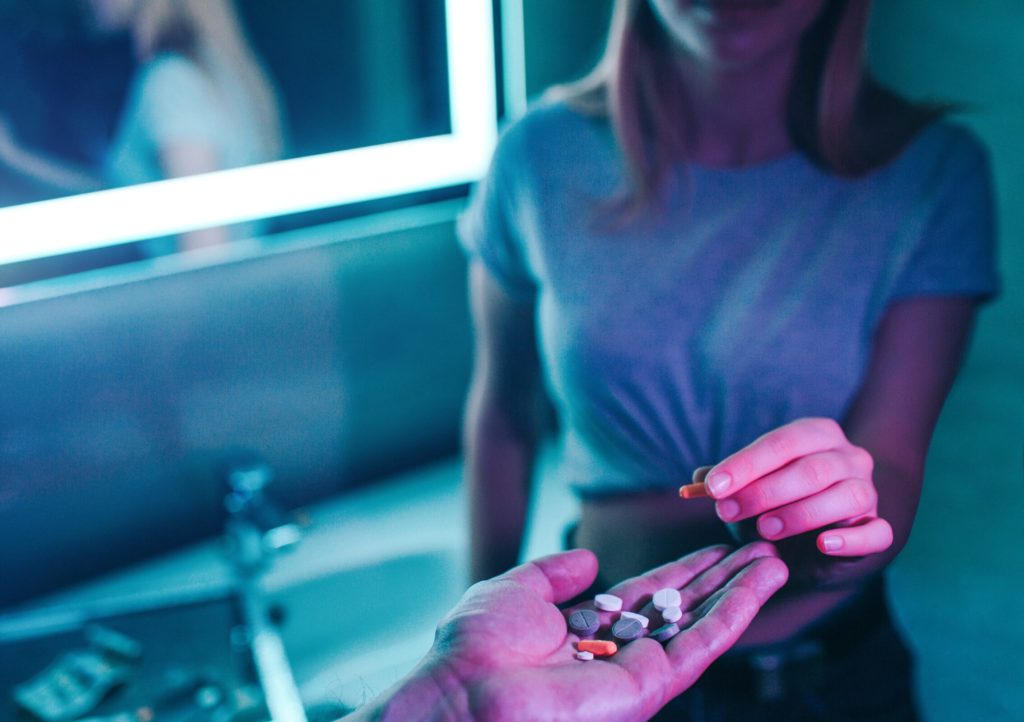Ecstasy, Molly, Adam, Empathy, Candy — no matter what you call it, MDMA (3,4-Methylenedioxymethamphetamine) use is a common sight among young LGBT persons throughout the United States. An observational study conducted by psychologist Perry N. Halkitis of gay men in New York City found that poly-drug use of ecstasy, methamphetamine, and GHB were highly correlated with one another. This means that the likelihood of a man reporting he had used one of those drugs would influence the likelihood he had used the others within the past year.
Ecstasy’s history in the United States is complicated. Among all of the debate surrounding its legality are countless young people who believe even casual use of MDMA is harmless when Pride rolls around. Popular at music festivals and dance parties, MDMA has inserted itself into party culture, so much in fact that it’s nearly unavoidable to encounter someone “rolling” (the term for MDMA use) at these events.
What is ecstasy?

MDMA (3,4-Methylenedioxymethamphetamine) is a stimulant molecule that causes intense feelings of euphoria, confidence, sociability, and energy. It accomplishes this by binding to serotonin and dopamine receptors across the brain, and does two distinct things:
- Inhibits the reuptake of serotonin, preventing it from returning to the presynaptic neuron.
- Increases the release of serotonin by changing the ion gradient at the synapse. More serotonin is released as a result of this flip in gradient.
It can come in the form of either crystalline “rock,” as in the case of Molly, or as a “pressed pill,” that is stamped with logos from pop culture. It is usually taken by mouth. Its effects are evident after 30-60 minutes. Side effects include:
- Increased body temperature.
- Nausea
- Pupil dialation
- Jaw clenching
- Chills
- Blurry vision
Along with all of these immediate side effects, ecstasy is most well-known for its ability to cause overwhelming feelings of euphoria for hours at a time. While its effects do not last as long as other stimulants, the associated comedown can be brutal. Comedowns are:
- Reduced energy, fatigue
- Prolonged feelings of sadness
- Anxiety
- Decreased appetite
- Anhedonia
Despite all of these caveats, MDMA remains popular in the party scene. This may have something to do with the common misconceptions surrounding the drug, minimizing its perceived harm while touting its purported benefits. Today, we’re going to debunk 5 myths about ecstasy you may have heard of.
Myth #1 – Ecstasy is not harmful in the long term.
Many studies examining low-dose or novel users of MDMA often find that obvious brain changes are not detectable in acute use scenarios. However, long-term changes in the brain due to heavy chronic exposure to MDMA have been found, including reduced concentration of serotonin and dopamine receptors due to neurotoxicity. As these receptors are critical for regulating mood and motor movements, their death may be associated with depression, anxiety, fatigue and thoughts of suicide.
Chronic heavy MDMA use destroys axons across the forebrain. Axons are the projections from neurons that transmit signals to other neurons’ dendrites. Once these are destroyed, they can’t transmit signals and reduce neural function overall. This is evident in studies examining attention and cognition in both heavy and “light” users of MDMA, with MDMA users of all calibers scoring worse in tests of attention and memory compared to controls.
Beyond that, there is some evidence that heavy MDMA use can cause the formation of tangles in the brain by adding a phosphate group to tau, a molecule responsible for maintaining the structural integrity of our neural tubules. Hyperphosphorylated tau (as it is referred to) is a risk factor for developing dementia.
Myth #2 – You cannot get addicted to ecstasy.
This myth requires some explanation. Studies have shown that MDMA withdrawals are less physical and more psychological in nature, but they maintain a risk of addiction. This is mainly due to MDMA’s ability to alter dopaminergic neurons in the nucleus accumbens, as is the case with other drugs with addiction potential. Tolerance develops extremely quickly after even small doses of the drug. This means that an individual must consume more each time to experience the same effects.
While physical dependence isn’t typical for MDMA abusers, psychological dependence can develop as individuals begin to rely on the drug every time they go out or party. A sign of MDMA dependence is when a person can’t stop using high doses of MDMA despite knowing its risks.
Myth #3 – Ecstasy is safer than other party drugs.
A common misconception is that MDMA is “safer” than other common drugs of choice in the festival circuit. This is inaccurate. MDMA overdoses can happen just as easily, especially when combined with alcohol. An MDMA overdose includes:
- Hyperthermia, or overheating
- Fluid loss
- Kidney failure
- High blood pressure
- Panic attacks
- Seizures
- Convulsions
A person who has taken too much MDMA can die of multiple organ failure due to hyperthermia, primarily. Unlike opioid overdoses where Narcan is used to immediately stop symptoms, no such remedy exists for MDMA overdose. Physicians focus on rehydrating and bringing the body down to normal temperature in order to increase the likelihood of survival.
Because of this myth that MDMA is “safer,” partiers may be tempted to take more of the drug. Combined with the reduced inhibitions associated with alcohol, individuals may not be aware of how many tablets of ecstasy they are consuming.
Myth #4 – Brain damage from ecstasy is permanent*
This is where we shift gears a bit. After all of this explanation of the toxic damage chronic and heavy MDMA use can cause, there is definitely hope.
The good news is that it appears certain types of damage attributed to MDMA can be stopped. In fact, they can be reversed. For one, while there is currently no drug similar to Narcan where it could halt an MDMA overdose emergency, researchers have found that certain benzodiazapines like clonazepam (Klonopin) can immediately reverse hyperthermia and quite literally keep the brain from overheating. More research is needed on how safe and effective this treatment is, especially in emergency situations.
Even the neurotoxic damage associated with MDMA may not be a life sentence. A recent review found that as compared to other illicit drugs, MDMA’s effect on long-term cognitive health was unclear. While neurotoxic damage to the serotonin system was present in heavy users of MDMA, their behavioral consequences were subtle. In addition to that, studies using magnetic resonance imaging (MRI) and spectroscopy (SPEC) suggest that the brain’s immune system attempts to repair areas that experienced oxidative stress as a result of MDMA, indicated by the greater concentration of glial cells in the striatum and hippocampus. Even early studies on MDMA neurotoxicity found that while high doses destroyed serotonin-dependent neural tissue in monkeys, long periods of abstinence allowed these branches of tissue torepair, though in different places across the brain.
How can La Fuente Hollywood Treatment Center help with drug dependence?

Our team recognizes the importance of addressing dependence on MDMA, especially when the temptation to try it is made even more difficult with all of these misleading claims about its “safety”. We are proud to serve the LGBTQ community with care that is evidence-based, and identity-affirming. We address the unique challenges our resilient community faces every day.
If you or someone you love is struggling with dependence, please contact our team.




